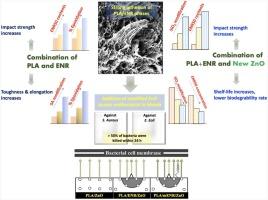当前位置:
X-MOL 学术
›
Ind. Crops Prod.
›
论文详情
Our official English website, www.x-mol.net, welcomes your
feedback! (Note: you will need to create a separate account there.)
Utilization of modified epoxidized natural rubber and zinc oxide on properties of polylactic acid/epoxidized natural rubber blends: Mechanical properties, antibacterial efficiency and biodegradability
Industrial Crops and Products ( IF 5.6 ) Pub Date : 2024-07-13 , DOI: 10.1016/j.indcrop.2024.119102 Yeiangchart Boonluksiri , Phoempon Siangdang , Jobish Johns , Yeampon Nakaramontri
Industrial Crops and Products ( IF 5.6 ) Pub Date : 2024-07-13 , DOI: 10.1016/j.indcrop.2024.119102 Yeiangchart Boonluksiri , Phoempon Siangdang , Jobish Johns , Yeampon Nakaramontri

|
Polylactic acid (PLA) is a biopolymer with brittleness and no antibacterial efficiency, which can be solved by the combination with epoxidized natural rubber (ENR) due to polar-polar interaction and with modified zinc oxide nanoparticles (ZnO) regarding the releasing of zinc ions (Zn) and reactive oxygen species (ROS). To minimize self-interaction in each PLA and ENR molecular chain, ENR with different % epoxidation was modified (mENR) by grafting with sebacic acid (SA). The addition of mENR with 50 % mol to PLA significantly improved the properties of pure PLA in terms of mechanical and impact properties, toughness, and also provided disinfectant ability. Regarding antibacterial properties, the efficiency against and was significantly improved by adding ZnO to the blends. Combination of mENR to PLA matrix during mixing operation increases improved ZnO dispersion and distribution in PLA/mENR blends. Thus, antibacterial efficiency had been enhanced using proper mENR:ZnO concentration ratios in the PLA matrix, relative to other modified ZnO types. Also, incorporation of mENR:ZnO enhanced impact strength and retarded biodegradability of the blends due to hydrophobicity of ENR in PLA matrix. The findings of the blends' properties suggest potential for new functional applications, especially in disinfectant sheet lamination products where strength and protection against bacterial growth together with proper degradation period are required.
中文翻译:

改性环氧化天然橡胶和氧化锌对聚乳酸/环氧化天然橡胶共混物性能的影响:机械性能、抗菌效率和生物降解性
聚乳酸(PLA)是一种脆性且无抗菌功效的生物聚合物,可以通过与环氧化天然橡胶(ENR)结合(由于极性相互作用)和与改性氧化锌纳米颗粒(ZnO)结合(释放锌离子)来解决。 (Zn) 和活性氧 (ROS)。为了最大限度地减少每个 PLA 和 ENR 分子链中的自相互作用,通过用癸二酸 (SA) 接枝来修饰具有不同环氧化百分比的 ENR (mENR)。在PLA中添加50%摩尔的mENR显着改善了纯PLA的机械性能、冲击性能、韧性,并且还提供了消毒能力。在抗菌性能方面,通过在共混物中添加 ZnO,抗菌效率得到显着提高。在混合操作过程中,mENR 与 PLA 基质的组合可改善 ZnO 在 PLA/mENR 共混物中的分散和分布。因此,相对于其他改性 ZnO 类型,在 PLA 基质中使用适当的 mENR:ZnO 浓度比可以提高抗菌效率。此外,由于 PLA 基质中 ENR 的疏水性,mENR:ZnO 的加入增强了共混物的冲击强度并延迟了生物降解性。混合物特性的发现表明了新功能应用的潜力,特别是在需要强度和防止细菌生长以及适当降解期的消毒片层压产品中。
更新日期:2024-07-13
中文翻译:

改性环氧化天然橡胶和氧化锌对聚乳酸/环氧化天然橡胶共混物性能的影响:机械性能、抗菌效率和生物降解性
聚乳酸(PLA)是一种脆性且无抗菌功效的生物聚合物,可以通过与环氧化天然橡胶(ENR)结合(由于极性相互作用)和与改性氧化锌纳米颗粒(ZnO)结合(释放锌离子)来解决。 (Zn) 和活性氧 (ROS)。为了最大限度地减少每个 PLA 和 ENR 分子链中的自相互作用,通过用癸二酸 (SA) 接枝来修饰具有不同环氧化百分比的 ENR (mENR)。在PLA中添加50%摩尔的mENR显着改善了纯PLA的机械性能、冲击性能、韧性,并且还提供了消毒能力。在抗菌性能方面,通过在共混物中添加 ZnO,抗菌效率得到显着提高。在混合操作过程中,mENR 与 PLA 基质的组合可改善 ZnO 在 PLA/mENR 共混物中的分散和分布。因此,相对于其他改性 ZnO 类型,在 PLA 基质中使用适当的 mENR:ZnO 浓度比可以提高抗菌效率。此外,由于 PLA 基质中 ENR 的疏水性,mENR:ZnO 的加入增强了共混物的冲击强度并延迟了生物降解性。混合物特性的发现表明了新功能应用的潜力,特别是在需要强度和防止细菌生长以及适当降解期的消毒片层压产品中。











































 京公网安备 11010802027423号
京公网安备 11010802027423号